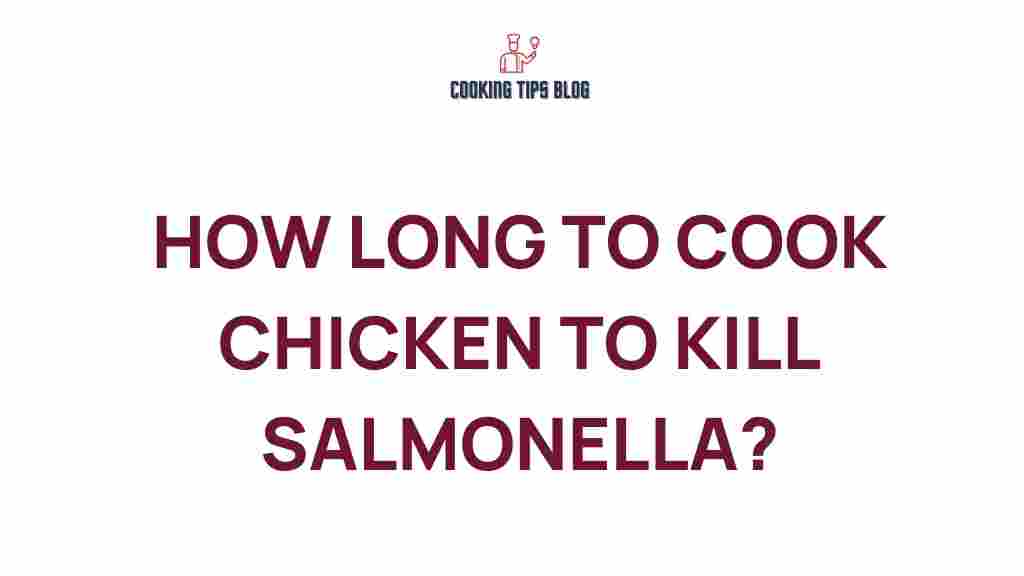The Crucial Timing: How Long to Cook Chicken to Eliminate Salmonella
Cooking chicken properly is essential not only for flavor but also for food safety. One of the most dangerous bacteria associated with poultry is Salmonella, which can cause severe foodborne illness. To eliminate this bacteria, it is crucial to understand the correct chicken cooking time. In this article, we will delve into the recommended cooking times, methods, and tips to ensure your chicken is both delicious and safe to eat.
Understanding Salmonella in Chicken
Salmonella is commonly found in raw chicken and can lead to serious health issues. Symptoms of a Salmonella infection include:
- Diarrhea
- Fever
- Abdominal cramps
- Nausea and vomiting
It is crucial to handle raw chicken with care and to cook it to the appropriate internal temperature to kill any harmful bacteria.
Recommended Chicken Cooking Time
The chicken cooking time varies depending on the method of cooking and the cut of chicken being used. The USDA recommends cooking chicken to an internal temperature of 165°F (75°C). Here’s a breakdown of cooking times for different methods:
1. Baking
When baking chicken in the oven, use the following guidelines:
- Whole chicken: Bake at 350°F (175°C) for 20 minutes per pound.
- Bone-in chicken pieces: Bake at 375°F (190°C) for 30-40 minutes.
- Boneless chicken breasts: Bake at 375°F (190°C) for 20-30 minutes.
2. Grilling
Grilling chicken adds a smoky flavor and requires attention to cooking times:
- Whole chicken: Grill over indirect heat for about 1.5 to 2 hours.
- Bone-in chicken pieces: Grill for 30-40 minutes, turning frequently.
- Boneless chicken breasts: Grill for 6-8 minutes per side.
3. Boiling
Boiling is a quick method for cooking chicken:
- Whole chicken: Boil for about 1 hour or until fully cooked.
- Bone-in pieces: Boil for 30-40 minutes.
- Boneless chicken breasts: Boil for 15-20 minutes.
4. Slow Cooking
Using a slow cooker is convenient but requires longer cooking times:
- Whole chicken: Cook on low for 6-8 hours or on high for 4-5 hours.
- Bone-in pieces: Cook on low for 4-6 hours or on high for 2-3 hours.
- Boneless chicken breasts: Cook on low for 3-4 hours or on high for 1.5-2 hours.
Using a Meat Thermometer
To ensure that chicken is cooked safely, using a meat thermometer is highly recommended. Insert the thermometer into the thickest part of the chicken, avoiding bones. The chicken is safe to eat when it reaches an internal temperature of 165°F (75°C). This method is the best way to verify that your chicken is cooked thoroughly.
Common Cooking Mistakes to Avoid
To ensure that your chicken is both safe and delicious, avoid these common mistakes:
- Not Preheating the Oven: Always preheat your oven before baking chicken to ensure even cooking.
- Cooking from Frozen: Never cook chicken from a frozen state. Always thaw it in the refrigerator before cooking.
- Overcrowding the Pan: Give chicken pieces enough space to cook evenly; overcrowding can lead to uneven cooking.
- Checking Temperature Incorrectly: Make sure to check the internal temperature in the thickest part of the meat.
Step-by-Step Cooking Guide
Here’s a simple step-by-step guide to cooking chicken safely:
Step 1: Preparation
Start by gathering your ingredients and tools:
- Raw chicken
- Your choice of marinade or spices
- A meat thermometer
- Cooking oil (if needed)
Step 2: Thawing
If your chicken is frozen, thaw it safely in the refrigerator for several hours or overnight. Avoid thawing at room temperature.
Step 3: Seasoning
Season the chicken as desired. Marinades can enhance flavor, and spices can add zest.
Step 4: Cooking
Choose your preferred cooking method and follow the recommended chicken cooking time for that method. Use a meat thermometer to check the internal temperature.
Step 5: Resting
Once the chicken is cooked, let it rest for at least 5-10 minutes before slicing. This allows the juices to redistribute and keeps the meat moist.
Troubleshooting Tips
Sometimes things don’t go as planned in the kitchen. Here are some troubleshooting tips:
- Chicken is Still Pink: If the chicken appears pink but has reached the correct internal temperature, it may be due to the presence of myoglobin. As long as it reaches 165°F (75°C), it is safe to eat.
- Dry Chicken: If your chicken turns out dry, consider brining it before cooking or using a marinade to add moisture.
- Uneven Cooking: Make sure to cut chicken pieces into similar sizes for even cooking, and avoid overcrowding the pan.
Storing Leftover Chicken
Properly storing leftover chicken is crucial for food safety:
- Refrigerate leftovers within two hours of cooking.
- Store in an airtight container to maintain freshness.
- Consume refrigerated leftovers within 3-4 days.
- For longer storage, freeze chicken in a freezer-safe container for up to 4 months.
For more information on food safety and cooking tips, you can visit the USDA Food Safety and Inspection Service.
Conclusion
Cooking chicken safely is vital for ensuring a delicious meal and preventing foodborne illness. By following the appropriate chicken cooking time guidelines and using a meat thermometer, you can confidently serve chicken that is both flavorful and safe to eat. Remember to handle raw chicken with care and store leftovers properly. With these tips, you’re well on your way to mastering chicken cooking in your kitchen!
If you’re looking for more cooking tips and recipes, check out our Cooking Resources.
This article is in the category Healthy and created by Cookingtipsblog Team
